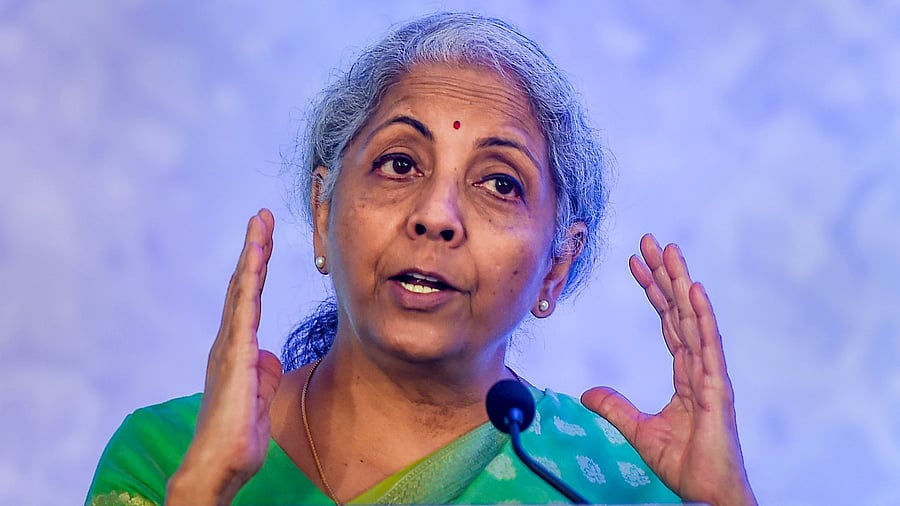
Finance Minister Nirmala Sitharman.
Credit: PTI Photo
Bengaluru: An economy slowing down due to a squeeze in urban consumption, inflation, unemployment, India trailing in the race for emerging technologies including artificial intelligence and geopolitical uncertainties surrounding US President Donald Trump’s tariff and trade policies form the backdrop as Finance Minister Nirmala Sitharaman and her core team set about putting the final touches to the Union Budget 2025-26.
Sitharaman will present a record eighth budget on February 1. Before that, the Economic Survey 2024-25, drafted by Chief Economic Advisor V Anantha Nageswaran and his team, will be tabled in Parliament on Friday.
Economists agree that Sitharaman will have to ease the tax burden of a disillusioned urban middle class, which drives consumption demand. Experts say the budget may bring in a ‘progressive’ income tax regime.
“It is quite necessary to have some income tax cuts if you want to spur consumption. But it will have to be across the board, across all brackets, not just in the lower taxable income brackets,” Madan Sabnavis, Chief Economist, Bank of Baroda, told DH. Sabnavis said there is a case of pent-up demand in the ‘middle’ middle class, those in the Rs 10-30 lakh per annum bracket.
Any tax breaks for this bracket will spur consumption. Hit by the reality of rise in prices being steeper than rise in wages, unemployment and fewer career growth opportunities, the salaried classes are feeling squeezed.
Top executives from automotive, FMCG, and the real estate sector have been vocal about the urban consumption slowdown hitting their margins. And it is showing in official data as well. India’s GDP is expected to grow 6.4% in the current financial year (2024-25), the slowest pace of growth since the Covid-19 pandemic.
“We estimate that the government can ensure better tax compliance and bolster consumption through enhancing disposable income, by moving all and one under the new tax regime, at a nominal loss by foregoing certain amount of tax collection,” Soumya Kanti Ghosh wrote in a pre-budget research report. Ghosh is Chief Economic Advisor, State Bank of India, and member, Sixteenth Finance Commission.
The government is expected to table a new tax code in the upcoming Budget Session of Parliament. Analysts expect Sitharaman to stay on the path of fiscal consolidation, while continuing to boost infrastructure spending and increase allocations to the Modi government’s flagship schemes.
On job creation, economists believe that emphasis will remain on boosting employment in the manufacturing sector. Sitharaman had announced a Rs 2 lakh crore outlay on job creation in the July 2024 budget, including on employment-linked incentive schemes and the PM internship scheme. These have not yet picked up.
There also needs to be a focus on improving employment and skilling in emerging technologies. The budget will be presented days after China’s DeepSeek AI tool showed how far India has fallen behind in the deeptech race.
“Through production-linked incentive (PLI) schemes, India has placed emphasis on areas where it lacks the capacity. They have been a positive experiment in that they have worked in some sectors. There is an expectation that the next round of PLIs may be announced, and emerging technologies could be a big part of that,” Rahul Bajoria, Head of India and ASEAN Economic Research, Bank of America, told DH.
“It becomes very important for the budget to increase allocation on emerging tech. India cannot be left behind. Higher allocations can be expected, both in terms of research and development, and implementation,” said BoB’s Sabnavis. Over to the Finance Minister.
Union Budget 2025 | Nirmala Sitharaman, who continues to be Finance Minister, will present her record 8th Union Budget this time. While inflation has burnt a hole in the pockets of 'aam janata', reports suggest there might be a tax relief for those making up to Rs 15 lakh per year. Track the latest coverage, live news, in-depth opinions, and analysis only on Deccan Herald. Also follow us on WhatsApp, LinkedIn, X, Facebook, YouTube, and Instagram.